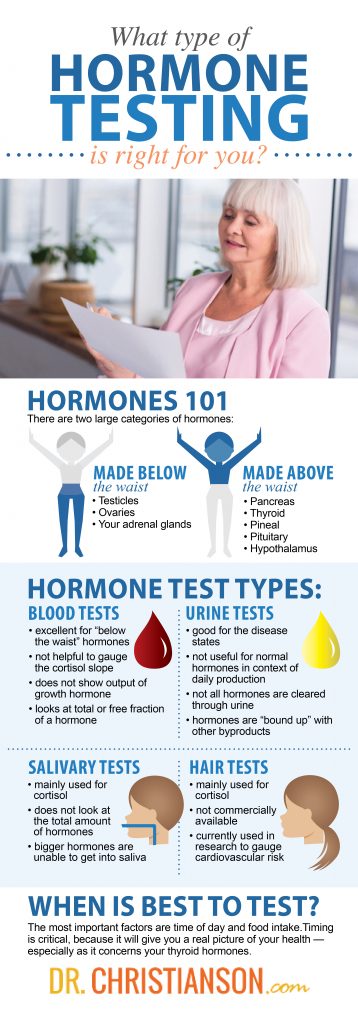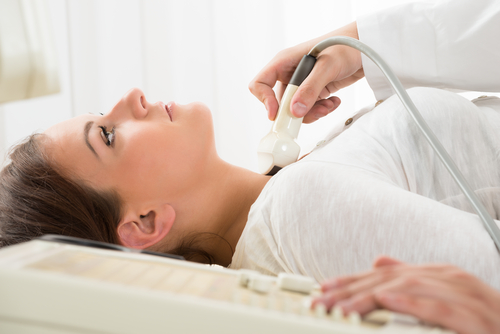There are many types of hormone tests on the market, but how do you know which one is best for you?
I want to help you gain a better understanding of your hormones, how to test them, and which tests are the most accurate, beneficial, and important for your health.
Let’s work together to make sense of your hormones today.

Hormones 101
When I think about hormones, I often divide them into two large categories. These are:
- The ones we make below the waist, and
- The ones we make above the waist
This is a pretty clear and simple way to understand your different types, but let’s dive a little bit deeper. When it comes to the ones below your waist, these are the ones made by your:
- Testicles
- Ovaries
- Your adrenal glands
If we go above the waist, we can see them influenced by our:
- Pancreas
- Thyroid
- Pineal
- Pituitary
- Hypothalamus
Sex Hormones
When we are talking “below the waist,” we are discussing our sex hormones.
These are distinct because they are modified versions of cholesterol (which is to say that they are made out of cholesterol).
The main sex hormones are “estrogenic hormones”. These include:
- Estradiol
- Estriol
- Estrone
We also have the androgenic hormones. The main ones include:
- Testosterone
- DHEA
- Androstenedione
Finally, we have the main adrenal hormones. These are some you might have heard before, including:
- Cortisol
- Cortisone
- DHEA
- Pregnenolone
Above The Waist
When we go beyond the sex hormones, we need to understand that these hormones are no longer cholesterol byproducts. Instead, they are protein chains. This means that they are long strings of amino acids, these include:
- Thyroid hormones (fT3, fT4, rT3)
- Pituitary hormones (FSH, LH, ACTH, TSH, HGH)
- Pancreatic hormones (Insulin and glucagon)
- Liver hormones (IGF-1)
The general idea here is that the hypothalamic hormones tell the pituitary hormones what to tell all of the other glands. Think about it like this: the hypothalamus is essentially the CEO, the pituitary is the manager, and the remaining glands are all the workers.
As the CEO, the hypothalamus communicates to the manager (the pituitary) what to tell the workers so that they can get the job done.
The Range of Hormone Tests
A few years ago, I was really diving deep into the world of hormone tests. I even thought of an idea that would illustrate the range of hormone tests and their results.
So, I had a bunch of different tests done so that I could analyze the results and could see what happened!
(Please use dots below images to scroll between tests)
At the time, I was in my early 40s and had no symptoms (and good health, overall).
I was also a fairly competitive athlete, too. Given this knowledge, there were some things that one could expect with regards to cortisol balance and androgenic/estrogenic hormones.
By and large, it is incredibly interesting to see how the salivary tests, the blood tests, and the urine tests differed in terms of their results.
In particular, you could see some findings that would simply not make sense. In those cases, that all ties into the inherent variability in these types of hormone tests.
Hormone Tests: Types
As I mentioned previously, there are three key types of hormone tests (and one other type that I will briefly touch on) that I want to make sense of with you. Let’s get started.

Blood Tests
Blood tests primarily look at the total or the free fraction of a hormone.
If they are not specified, such as in the case of T3 or testosterone, that is looking at the total amount of hormone.
Key Insight: When we say the word “total,” we are discussing how much of the hormone is free and active. This is in conjunction with how much is bound up and inactive. In most cases, the amount of free hormone is not unpredictable (instead, it is pretty reasonable).
There are times where you might have more or less free hormone than you might expect. In these cases, total hormone tests can give you results that frankly do not make sense.
For example, someone might have an overall high level of testosterone, but a large percentage of it is bound up by carrier proteins.
This means that the active free amount is quite small, which means that they could have symptoms of low testosterone even when their test results indicate that they have a large total amount. The same applies to thyroid hormones.
Bottom Line: The one major consideration of blood tests is that you really need to make the distinction between total and free amounts. Otherwise, you may have results that just do not line up with how you feel, and will not make any sense.
The Key Factor: Timing
Another thing that we need to consider, when it comes to blood tests, is the matter of timing. Blood tests show the hormone level at the time of drawn blood. This is important because some hormones have a strong circadian cycle.
Cortisol, for example, if you were to measure it in the morning versus the afternoon, you would get a very different number each time.
You need to be able to distinguish between that, in order to get an accurate read of your hormone levels.

Key Insight: When it comes to cortisol, it is just as important to note that the act of the blood draw itself can skew cortisol levels. No one loves a needle, but did you know that it can have an effect on cortisol levels? Please make sure you keep that in mind when you do get tested.
Another thought that comes from the fact that this is an instant test, with instant results, is that some hormone levels do vary throughout a predictable rhythm (such as one’s menstrual cycle).
Throughout the course of a woman’s cycle, where you test those hormones can be completely different depending on when you administer the test.
Challenge Tests
There is also the matter of challenge tests. When it comes to blood tests, we can also measure the pituitary response, or the glandular response, to receiving some form of challenge substance.
This can be done with any one of the following “challenge substances”:
- ACTH
- HGH
- Thyrotropin
- Glucose
- Insulin
Bottom Line: It is important to get a read on these various hormones on their own. That said, it is also important to see how they react under the state of a challenge. It can give us a sense of how our hormones are performing, and how they respond to certain situations which can be even more indicative of their overall state.
Drawbacks
There are a couple of drawbacks that we should keep in mind when it comes to challenge tests. They are as follows:
- Cortisol Slope – Blood tests are not helpful when it comes to gauging between your morning and nighttime cortisol levels.
- Direct Growth Hormone Output – Most of the growth hormone that we make occurs in the middle of the night, for short periods of time. For this reason, blood levels will not show the output of growth hormone.
- Disease States With Sporadic Overproduction – In the same vein as the previous points, there are some diseases which have sporadic (random) moments of overproduction. A blood test, because it is only a read of the moment it is taken, may not show these unless the timing is absolutely perfect.
Benefits
With the drawbacks in mind, here are some of the major key benefits that we can get from blood tests:
- Sex Hormones
- Thyroid hormones
- Adrenal hormones (Read: The 7 causes of adrenal stress and how you can end them today)
Bottom Line: Blood tests are excellent for any of those “below the waist” hormones, as they are able to give a proper read on how those are functioning at a given point in time.
Urine Tests
This is another big category that I want to talk about. There are four different versions of urine tests that are worth mentioning:
- 24 hour
- Spot
- Circadian
- Circadian-Spot (known as the Dutch test)
The general impetus behind urine tests is that hormones can be found in the urine. The added benefit is that, because the hormones take longer to get there, you can level out and determine how they might vary from moment to moment.
As I mentioned before, urine tests could be very useful in determining if you are currently in a disease state that causes erratic, random overproduction of your hormones.
It gives us a bigger picture, which can often point to trends that can provide more information on your well being. This is the key benefit of a 24-hour urine test.
Spot hormone urine tests can check your hormones at a set point in time. The drawback is that the time in which you take the test is not necessarily reflective of your hormone levels at that exact time.
Instead, you need to consider that your hormones need between 1 – 8 hours to come out in your urine.
This brings us to a new method known as the Dutch test (which is a combination of options 2 and 3 that I have mentioned above).
The Dutch test seeks to take multiple samples, throughout the day, in order to gain a clearer picture of your full day’s production of hormones.
This, ultimately, seeks to combat the fact that the range of hormone production to urine output is so varied, you cannot put an accurate timestamp on it.
Drawbacks
Some of the drawbacks we can consider for urine tests include:
- Conjugated Hormones – Where the hormones are essentially “bound up” with other byproducts in your system.
- Clearing Hormones – Not all your hormones are cleared through your urine, as some have to go through your stool (which results in the fractions being inconsistent).
Benefits
Urine tests are really only good for how you dispose of hormones, and how much your output is at extremes.
Ultimately, this means that urine tests are only good if you are not concerned with the exact time of production.
They are, however, good for the disease states, which include things like:
- Cushing’s disease
- Pheochromocytoma
- Carcinoid syndrome
They are not really useful for normal hormones, in the context of daily production. This includes everything from:
- DHEA
- Estrogens
- Androgens
- Progesterone
- Growth hormones
- Thyroid hormones
Salivary Tests
In the same way that urine tests are delayed, salivary tests are very acute – which means that they relate to a very tight and specific point in time. This makes salivary tests a great tool for measuring cortisol slope.
Not with regards to the whole output of cortisol, rather the way our cortisol output varies throughout the course of the day.
This draws back to our previous point about free and total hormones. Your saliva is looking at the free fraction, and not the total amount of hormone.
Another limitation involved with salivary tests is that some hormones, simply by their molecular size, get into the saliva. Bigger hormones, because of their size, are unable to get into your saliva due to their fractions.
There are hormones in the saliva, and then there are hormones which are bound up in the blood cells. Therefore, it is not uncommon to have some microscopic amounts of blood cells in your saliva.
Because there can be large amounts of hormone tied into your blood cells, even microscopic levels in your saliva can skew your levels.
Bottom Line: With all of that in mind, salivary tests are really not helpful for anything besides cortisol. While there are panels which measure things like DHEA and thyroid hormone, they are not meaningful due to the chemistry of saliva.
Hair Tests
Believe it or not, there are hair tests in existence for hormone levels!
Much like salivary tests, hair tests are mainly for cortisol. This was conceived because we know that cortisol is made by the adrenals, but that the liver, the brain, and visceral fat also have a role to play too.
Hair cortisol is done to check that whole body burden. Currently, hair tests are not commercially available. They are currently used in research to gauge cardiovascular risk in patients from cortisol.
When Is The Best Time To Test?
The most important things to note here is that time of day matters, and so does eating something.
For your thyroid hormones, it is best to test first thing in the morning, before eating, and before taking your thyroid medication.
For menstruating women, if you are looking to gauge the levels of your reproductive hormones, the best time to test is at about day 17 – 23 of your cycle.
If you are taking a dose of hormones, you need to think of testing in terms of your medication. Think of it like this, you need to wait:
- 12 to 24 hours for pills
- 3 to 6 hours for creams and lozenges
- 2 to 4 days for injections
- 3 to 5 weeks for pellets
This will ensure that you are getting the most accurate results, every time. Timing is critical, because it will give you a real picture of your health – especially as it concerns your thyroid hormones.

Your Optimal Hormone Testing

Today we have discussed the different types of hormone tests, and what they are good for in the context of your overall health.
Speaking of tests, I would love for you to start learning a bit more about your health by taking either the Thyroid Quiz (Click Here) or the Adrenal Quiz (Click Here) today.
Your health matters, so test, don’t guess!

1. Schedule a Thyroid Second Opinion with me, Dr. C, Click Here for Details
2. Download and use my Favorite Recipes Cookbook Here
3. Check out my podcast Medical Myths, Legends, and Fairytales Here
Dr. Alan Glen Christianson (Dr. C) is a Naturopathic Endocrinologist and the author of The NY Times bestselling Adrenal Reset Diet, The Metabolism Reset Diet and The Thyroid Reset Diet.
Dr. C’s gift for figuring out what really works has helped hundreds of thousands of people reverse thyroid disease, lose weight, diabetes, and regain energy. Learn more about the surprising story that started his quest.


